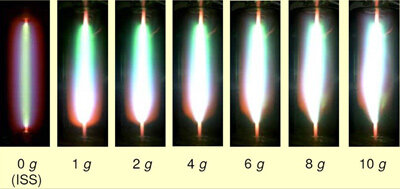New energy ideas tested aboard ISS
It may be the comic book symbol for a great idea, but it's easy to take the light bulb for granted. Research is continuing into the most efficient light bulbs which can also deliver a bright and warm light – whilst daylight is blue, we’re used the to the orange colour temperature of tungsten when we're indoors.
High-Intensity Discharge (HID) lamps are among the innovations in lighting which could help reduce demand on energy. These metal halide lamps have been tested in the ARGES experiment on board the International Space Station (ISS) and on ESA parabolic flights.
Inside the lamps, the gases can de-mix or separate away from each other over time. When the gases separate, the light given out is no longer uniform. Instabilities can also happen within the lamp. The central channel of the plasma can bend away from the central axis – in some cases even developing a corkscrew motion. This can cause the lamp to flicker and extreme cases lead to the gases being leaked out in which case the lamp will no longer work.
The ARGES experiment was designed to find out what factors caused the spiral formation instabilities, and to characterise the separation of individual gases in HID lamps using high-resolution emission spectroscopy.

The main objectives of this experiment are to determine which factors are critical in the onset of spiral formation instabilities in HID lamps and to characterise the separation of individual gaseous elements in HID lamps using high-resolution emission spectroscopy. Spectroscopy analyses the light emissions coming from the different elements within the lamp.
The experiments showed that an even spread of light through complete mixing of the gases, was possible under microgravity and at 10g (in a centrifuge) but that de-mixing occurred at intermediate gravity levels.
The ISS has also been vital for testing new solar cell technologies and for testing different insulators and thermal systems.




